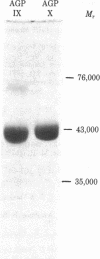Abstract
During malaria and other infections, the plasma concentration of alpha 1-acid glycoprotein (AGP) increases 3- to 4-fold, but the function of this glycoprotein has been unknown. This study demonstrates, by in vitro culture of the malaria parasite Plasmodium falciparum, that the AGP concentration achieved during malaria is sufficient to inhibit parasite multiplication by 80%. It was found that the inhibitory activity of AGP depends on and is a function of its sialic acid complement (12-16 mol/mol) and its higher-order structure. AGP acts by blocking parasite-erythrocyte interaction during the invasion process. These findings indicate a function for AGP with definite in vivo significance. Moreover, they reveal an important protective response to malaria and perhaps other infectious diseases.
Full text
PDF



Images in this article
Selected References
These references are in PubMed. This may not be the complete list of references from this article.
- Berger E. G., Wyss S. R., Nimberg R. B., Schmid K. The microheterogeneity of human plasma alpha1-acid glycoprotein. Hoppe Seylers Z Physiol Chem. 1980 Oct;361(10):1567–1572. doi: 10.1515/bchm2.1980.361.2.1567. [DOI] [PubMed] [Google Scholar]
- Breuer W. V., Ginsburg H., Cabantchik Z. I. An assay of malaria parasite invasion into human erythrocytes. The effects of chemical and enzymatic modification of erythrocyte membrane components. Biochim Biophys Acta. 1983 Jan 25;755(2):263–271. doi: 10.1016/0304-4165(83)90213-1. [DOI] [PubMed] [Google Scholar]
- Chiu K. M., Mortensen R. F., Osmand A. P., Gewurz H. Interactions of alpha1-acid glycoprotein with the immune system. I. Purification and effects upon lymphocyte responsiveness. Immunology. 1977 Jun;32(6):997–1005. [PMC free article] [PubMed] [Google Scholar]
- Dennis L. H., Eichelberger J. W., Inman M. M., Conrad M. E. Depletion of coagulation factors in drug-resistant Plasmodium falciparum malaria. Blood. 1967 May;29(5):713–721. [PubMed] [Google Scholar]
- Fournet B., Montreuil J., Strecker G., Dorland L., Haverkamp J., Vliegenthart F. G., Binette J. P., Schmid K. Determination of the primary structures of 16 asialo-carbohydrate units derived from human plasma alpha 1-acid glycoprotein by 360-MHZ 1H NMR spectroscopy and permethylation analysis. Biochemistry. 1978 Nov 28;17(24):5206–5214. doi: 10.1021/bi00617a021. [DOI] [PubMed] [Google Scholar]
- Franzblau C., Schmid K., Faris B., Beldekas J., Garvin P., Kagan H. M., Baum B. J. The interaction of collagen with alpha1-acid glycoprotein. Biochim Biophys Acta. 1976 Mar 18;427(1):302–314. doi: 10.1016/0005-2795(76)90306-8. [DOI] [PubMed] [Google Scholar]
- Howard W. A., Collins W. E. Heparin therapy in simian Plasmodium knowlesi malaria. Lancet. 1972 Oct 7;2(7780):738–739. doi: 10.1016/s0140-6736(72)92026-0. [DOI] [PubMed] [Google Scholar]
- Jensen J. B. Concentration from continuous culture of erythrocytes infected with trophozoites and schizonts of Plasmodium falciparum. Am J Trop Med Hyg. 1978 Nov;27(6):1274–1276. doi: 10.4269/ajtmh.1978.27.1274. [DOI] [PubMed] [Google Scholar]
- Klainer A. S., Clyde D. F., Bartelloni P. J., Beisel W. R. Serum glycoproteins in experimentally induced malaria in man. J Lab Clin Med. 1968 Nov;72(5):794–802. [PubMed] [Google Scholar]
- Kornfeld R., Kornfeld S. Comparative aspects of glycoprotein structure. Annu Rev Biochem. 1976;45:217–237. doi: 10.1146/annurev.bi.45.070176.001245. [DOI] [PubMed] [Google Scholar]
- Laemmli U. K. Cleavage of structural proteins during the assembly of the head of bacteriophage T4. Nature. 1970 Aug 15;227(5259):680–685. doi: 10.1038/227680a0. [DOI] [PubMed] [Google Scholar]
- Miller L. H., Haynes J. D., McAuliffe F. M., Shiroishi T., Durocher J. R., McGinniss M. H. Evidence for differences in erythrocyte surface receptors for the malarial parasites, Plasmodium falciparum and Plasmodium knowlesi. J Exp Med. 1977 Jul 1;146(1):277–281. doi: 10.1084/jem.146.1.277. [DOI] [PMC free article] [PubMed] [Google Scholar]
- Patwardhan V. N., Maghrabi R. H., Mousa W., Gabr M. K., el-Maraghy S. Serum glycoproteins in protein-calorie deficiency disease. Am J Clin Nutr. 1971 Aug;24(8):906–912. doi: 10.1093/ajcn/24.8.906. [DOI] [PubMed] [Google Scholar]
- Perkins M. Inhibitory effects of erythrocyte membrane proteins on the in vitro invasion of the human malarial parasite (Plasmodium falciparum) into its host cell. J Cell Biol. 1981 Sep;90(3):563–567. doi: 10.1083/jcb.90.3.563. [DOI] [PMC free article] [PubMed] [Google Scholar]
- Snyder S., Coodley E. L. Inhibition of platelet aggregation by alpha1-acid glycoprotein. Arch Intern Med. 1976 Jul;136(7):778–781. [PubMed] [Google Scholar]
- Trager W., Jensen J. B. Human malaria parasites in continuous culture. Science. 1976 Aug 20;193(4254):673–675. doi: 10.1126/science.781840. [DOI] [PubMed] [Google Scholar]
- WARREN L. The thiobarbituric acid assay of sialic acids. J Biol Chem. 1959 Aug;234(8):1971–1975. [PubMed] [Google Scholar]
- Weiss M. M., Oppenheim J. D., Vanderberg J. P. Plasmodium falciparum: assay in vitro for inhibitors of merozoite penetration of erythrocytes. Exp Parasitol. 1981 Jun;51(3):400–407. doi: 10.1016/0014-4894(81)90127-2. [DOI] [PubMed] [Google Scholar]




